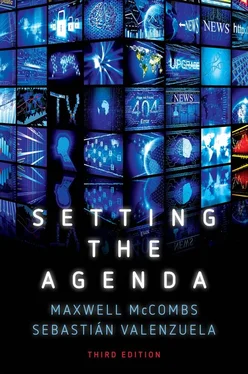These initial empirical efforts to map the agenda-setting role of the mass media encompassed three consecutive US presidential campaigns. Election settings were not selected because of any assumption that agenda-setting effects are limited to elections, but rather because national elections create a natural laboratory for the examination of media effects. During a national election there is a continuing massive barrage of messages on public issues and other aspects of politics. If these messages are to have any significant social effects, the effects must occur by election day.
In addition to these advantages for studying media effects, there is also an enduring tradition of scholarship on the role of mass communication in national elections that began with the seminal studies of Lazarsfeld and his colleagues, first in Erie County during the 1940 US presidential election and then in Elmira, New York, during the 1948 US presidential election. For all these reasons, the initial examinations of agenda setting were conducted in election settings.
However, the agenda-setting role of the news media is limited neither to elections nor to the United States, nor even to the arena of political communication broadly defined. American presidential elections were just the starting point. The phenomenon of agenda setting, a continuous and inadvertent by-product of the communication process, is found in both election and non-election settings, at both the national and local levels, in a wide array of geographical settings worldwide, and increasingly for a broad array of agendas extending beyond political communication. However, for now we will focus on issue agendas, the best mapped domain of the agenda-setting role of the communication media.
National concern about civil rights
From 1954 to 1976, a 23-year span encompassing half a dozen presidential elections and all the years in between, the salience of the civil rights issue in the United States rose and fell with great regularity in response to news coverage. 18The percentage of Americans naming civil rights as ‘the most important problem’ facing the country ranged from 0 to 52 per cent in the twenty-seven Gallup polls conducted during those three decades. When this continuously shifting salience of civil rights on the public agenda was compared with the news coverage on the front page of the New York Times for the month preceding each of the twenty-seven polls, the result was a robust correlation of +0.71. Even when the influence of news coverage in earlier months is removed, the correlation remains +0.71. This is especially compelling evidence of the media’s agenda-setting role. Also note that the salience of the civil rights issue among the public primarily reflects the preceding month of news coverage, a relatively short-term response to the media agenda. Because the media agendas examined over this 23-year period were prior in time to the public agenda, this evidence on time-order further supports agenda-setting’s causal assertion that the public agenda results, to a considerable degree, form the media agenda.
British and American concern about foreign affairs
Obviously, the news media are most people’s primary source of information about foreign affairs. In both the United Kingdom and the United States, the salience of foreign affairs regularly rises and falls in response to media attention. 19The salience of foreign affairs among the British public from 1990 to 2000 was significantly correlated (+0.54) with the number of foreign affairs articles in The Times . During an overlapping twenty-year period in the United States, 1981–2000, the salience of foreign affairs among the American public was significantly correlated (+0.38) with the number of foreign affairs articles in the New York Times . Beyond the sheer number of articles in each newspaper, there is an additional impact on the public agenda by news stories reporting home country involvement.
Public opinion in Germany
Weekly comparisons between the public agenda and media agenda in Germany across the entire year of 1986 revealed that television news coverage had a significant impact on public concern about five diverse issues: an adequate energy supply, East–West relations, European politics, environmental protection, and defence. 20
The energy-supply issue illustrates these agenda-setting effects. Early in 1986 this issue had low salience on both the news agenda and the public agenda. But a rapid rise in May on the news agenda was followed within a week by a similar rise on the public agenda. News coverage catapulted from fewer than a dozen mentions per week to over a hundred per week. Concern among the public about an adequate supply of energy, which had been around 15 per cent of the population, suddenly moved into the 25 to 30 per cent range. When news coverage subsequently declined, so did the size of the constituency expressing concern about Germany’s energy supply.
During this same year there were no agenda-setting effects on eleven other issues. As noted previously, the public is not a collective automaton passively waiting to be programmed by the media. The pattern of media coverage for some issues resonates with the public. For other issues, there is no resonance.
Agenda setting in a Swedish election
A panel study tracking the issue of unemployment during the 2006 Swedish national election found significant agenda-setting effects in this Northern European country. 21When the media focused on unemployment, people also rated unemployment an important issue. These agenda-setting effects were stronger among those with higher interest in political news.
Public opinion in Louisville
All our examples of the agenda-setting influence of the news media examined to this point have been grounded in presidential elections or national portraits of public opinion. But there are also agenda-setting effects on local public issues. We begin with the long-term public opinion trends in an American city, trends that are analysed for the aggregate agenda, as well as separately for the eight individual issues on that agenda. 22When the trends in public opinion from 1974 through 1981 in Louisville were compared to the news coverage of the Louisville Times , the overall correlation between the public agenda and the news agenda was +0.65. Further analysis examined the ebb and flow of concern across these eight years for each of the eight issues. Significant agenda-setting effects were found for the top four issues on the news agenda: education, crime, the local environment, and local economic development.
Despite their influence on many issues, the news media are not all-powerful dictators of public opinion. The issues ranking fifth and sixth on the Louisville Times’ agenda – public recreation and health care, respectively – are examples of reverse agenda setting, a situation where public concern sets the media agenda. The lack of media omnipotence is also detailed in two other instances. Public concern about local government was independent of the trends in news coverage, despite the fact that local government is one of the traditional staples of daily newspaper coverage. Perhaps heavy continuing coverage of local government – or any other topic, for that matter – becomes a blur of white noise rather than a stream of information. Not only was public concern about local government immune to any agenda-setting influence of the press, the trend in news coverage was also immune to any reverse agenda setting, even though local government ranked sixth on the public agenda during those years.
Local public opinion in Spain, Japan, and Argentina
Читать дальше












